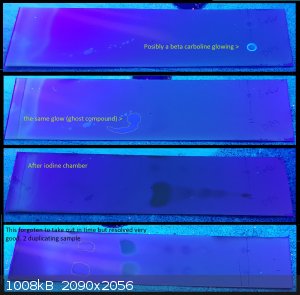Sinntetic
Harmless

Posts: 3
Registered: 18-1-2019
Member Is Offline
|
|
Inquire chemical expertise for identifying synthetical tryptamine derivative
Long story short.
In the land far far away exists some sort of methylated tryptamine derivative that in the past have exhibited dual properties. There are some concerns
of toxicological nature of this substance and so one venture for assistance in identification and quantification of said material.
Word say that it have been born during reductive methylation with
formaldehyde and sodium borohydride. It exhibits expected influence on
one's perception, but shows some properties that may indicate foreign
material in it's composition.
So have the person tested it's melting point to be 54.5 C, this does not
match the erowid stated 44.6 C. Thou Mr.Shulgin's notes show 57-59 C
and 67 C.
One would like to prepare it's fumarate salt for qualitative analysis, but
one is not in the possession of said acid unlike picric acid.
It would be very kind if some compassionate enthusiast explained the
orthodox procedure for preparation of picric acid salt and included some of
it's properties in reply to this inquiry.
And maybe indicate some of the possible side products of this methylation
pathway.
|
|
|
Elrik
Hazard to Self
 
Posts: 52
Registered: 1-9-2018
Member Is Offline
|
|
That post would have been easier to read if it were not the dream of a SWIMs pet unicorn, that just makes you sound really druggie and provides no
protection in any country I know of. But regardless.
You have picric acid, but dont have access to fumaric acid? Our basement labs do have their quirks, don't they!
This is from Practical Organic Chemistry by Vogel
| Quote: | Picric acid combines with amines to yield molecular
compounds (picrates), which usually possess characteristic melting points.
Most picrates have the composition 1 mol amine : 1 mol picric acid.
The picrates of the amines, particularly of the more basic ones, are
generally more stable than the molecular complexes formed between
picric acid and the hydrocarbons (compare Section IV,9,2).
If the amine is soluble in water, mix it with a slight excess (about
25 per cent.) of a saturated solution of picric acid in water (the solubility
in cold water is about 1 per cent.). If the amine is insoluble in water,
dissolve it by the addition of 2-3 drops of dilute hydrochloric acid (1:1)
for each 2-3 inl. of water, then add a slight excess of the reagent. If a
heavy precipitate does not form immediately after the addition of the
picric acid solution, allow the mixture to stand for some time and then
shake vigorously. Filter off the precipitated picrate and recrystallise it
from boiling water, alcohol or dilute alcohol, boiling 10 per cent, acetic
acid, chloroform or, best, benzene. |
Use toluene in place of benzene, obviously. And keep in mind that picric
acid is a dangerous explosive.
Do you have the materials to perform thin layer chromatography?
At the very minimum, a TLC kit can be manufactured from epsom salts, baking soda cooked in the oven, the glass from a small picture frame, and
distilled water. You can try a few different eluents to get an idea of how many compounds are in there.
On silica gel TLC a toluene/methanol eluent with a drop of strong ammonia added is known to work to separate tryptamine, NMT, and DMT.
Do you have a blacklight? ß-carbolines in salt form tend to glow under blacklight in solution. There may be some 1,2,3,4-tetrahydro-ß-carboline or
2-methyl-1,2,3,4-tetrahydro-ß-carboline depending on reaction conditions.
Do you have acetic anhydride or some similar acylating agent? There could be primary and secondary amines mixed in, they would loose their basic
properties if made into an amide.
I'm assuming infrared spectroscopy of column chromatographed fractions is not an option.
Ask your SWIMs unicorns pet leprechaun just how the synthesis was performed and what workup and testing was done and others may have more specific
advice, assuming I'm not the only one who will take you seriously 
|
|
|
Sinntetic
Harmless

Posts: 3
Registered: 18-1-2019
Member Is Offline
|
|
That was my best try to siwmroll around local censorship, I can assume it's accumulated indirect experience from reading this kind of posts 
The leprechaun said that, to the cooled methanolic solution of primary amine was added over say 1h (simultaneously) formaldehyde and sodium
borohydride methanolic solutions. Than HCl water sol. till pH of 3 decomposed the left over borohydride, pH was made neutral and ROH was cast away by
heat, what was left, basified and extracted in ether.
Ether washed with water, dried NaCO3, removed, 20min and bam, it's solid white rock cake.
p.s.
Unicorn prepared picrate salt that m.p. 146-149 C (167 C Shulgin) and 57-58 C free base (Erowid. Tomorrow he will try short path vac. destillation and
will repeat m.p. test((
|
|
|
Sinntetic
Harmless

Posts: 3
Registered: 18-1-2019
Member Is Offline
|
|
Made TLC can anybody please comment, just trying not to get poisoned it's a good motif 

|
|
|
|